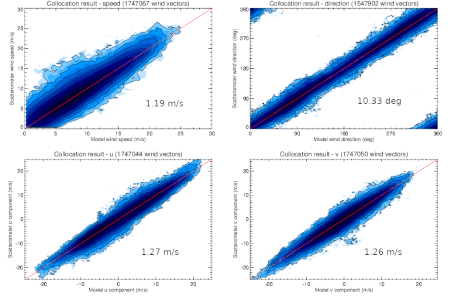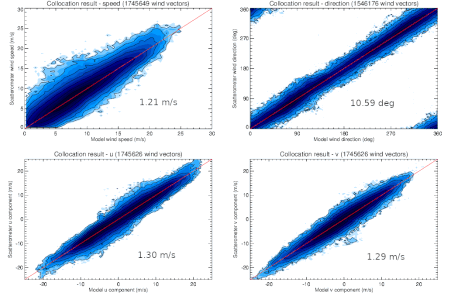| |
NSCAT-4DS geophysical model function
The NSCAT-4DS geophysical model function (GMF) is a further development from the NSCAT-4 GMF and
improves the consistency between Ku-band scatterometer winds on one hand, and C-band scatterometer
winds and buoy winds on the other hand.
NSCAT-4DS is now used in most near-real time OSI SAF Ku-band scatterometer wind products
and it is planned to be used as well for the generation of new climate data records.

SeaWinds NSCAT-4DS winds vs. ECMWF ERA5 forecast winds for
1 and 2 February 2008. The numbers in the wind speed, direction, zonal and
meridional wind panels, denote the standard deviation of difference between
SeaWinds and buoy winds (click to enlarge).

SeaWinds NSCAT-4 winds vs. ECMWF ERA5 forecast winds for
1 and 2 February 2008. The numbers in the wind speed, direction, zonal and
meridional wind panels, denote the standard deviation of difference between
SeaWinds and buoy winds (click to enlarge).
Heritage
The NSCAT-4 GMF was derived from the NSCAT-2 GMF and it is now superseded by NSCAT-4DS, which has
improved consistency for both wind Direction and Speed (hence the DS extension).
The NSCAT-4 description can still be found here.
Collocations of Metop/ASCAT and ScatSat-1/OSCAT winds, and ERS-2/SCAT and Adeos-I/NSCAT winds
have been used to derive wind direction and speed dependent corrections to NSCAT-4.
Since the Adeos-I/NSCAT instrument provides measurements at a large range of incidence angles, it was
possible to derive the corrections as a function of incidence angle. Rotating pencil beam instruments
like ScatSat-1/OSCAT only provide information for a single incidence angle.
The 2019 paper by Wang et al. (see below) describes the systematic inconsistencies
between C-band and Ku-band scatterometer winds. Most of them are reduced when
NSCAT-4DS is used. On top of that, a Sea Surface Temperature (SST) dependent backscatter
adjustment was developed that further reduces wind speed biases, see Wang et al. (2017). This
adjustment is a function of wind speed and SST and it is implemented in the Ku-band wind data
processors in use in the OSI SAF.
The original NSCAT-2 Ku-band geophysical model function (GMF) was empirically derived
from Adeos-I/NSCAT data and it is described in the paper by Wentz and Smith (see below).
Download
Binary tables and Pyhon script
(13 MB, use the "gunzip" and "tar -xf" commands to unpack on Unix/Linux).
The package contains binary HH polarisation and VV polarisation NSCAT-4DS tables for little endian and
big endian platforms. A Python script is included to read in the tables and plot the GMF.
More technical information can be found in the comments and descriptions
in the script.
References
Wang, Z., Stoffelen, A., Zhang, B., He, Y., Lin, W., Li, X.,
Inconsistencies in scatterometer wind products based on ASCAT and OSCAT-2 collocations
Remote Sensing of Environment, 2019, 225, 207-216,
doi:10.1016/j.rse.2019.03.005.
Wang, Z. et al.,
SST Dependence of Ku- and C-Band Backscatter Measurements
IEEE Journal of Selected Topics in Applied Earth O, 2017, 10, 5, 2135-2146,
doi:10.1109/JSTARS.2016.2600749.
Wentz, F. and D. Smith,
A model function for the ocean normalized radar cross section at 14 GHz derived from NSCAT observations
J. Geophys. Res., 1999, 104, C5, 11499-11514,
doi:10.1029/98JC02148.
Further information
Please contact the
KNMI scatterometer team.
| |
Near real time Wind Products
OSI SAF Wind Climate Data Records
Discontinued Wind Products
Software
R&D work
Projects
|
